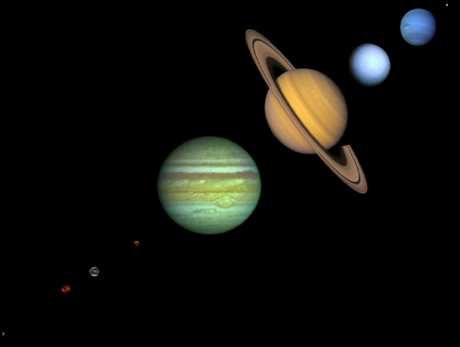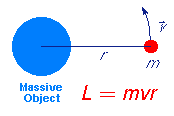 Conservation of Energy
Conservation of Energy
and Angular Momentum
Conservation laws are important because constrain
how physical systems change. Hidden in Newton's laws
are the conservation of energy, and the conservation of angular momentum.
Both of these principles are useful in understanding some of our
previous results and are fundamental in physics.
Energy Conservation
In the gravitational physics of orbits that we have been
considering there are two important forms of energy
that are being exchanged. GRAVITATIONAL POTENTIAL ENERGY
and KINETIC ENERGY. The kinetic energy is the energy associated with
a object's motion and is given by
Ekin= Mb V2/2.
where Mb is the mass, say of a ball, and V is the magnitude of the
velocity (the speed).
Now the gravitational potential energy is the energy that a body has which
can subsequently be used to
accelerate the body to a larger magnitude of velocity.
For example, if I hold a ball at arms
length at rest, and let the ball drop to the Earth, the ball will
speed up before hitting the Earth. This potential energy, as I was
holding the ball at rest, is
given by
Egrav=Mbg H,
where H is the height of the ball above the Earth's surface,
and g, the acceleration on the Earth is
g=(GMe/R2e) = 9.8 meters/s2
(see the inset figure in the discussion of weight on our earlier packet
of notes The Universal Law of Gravitation ).
Now here's the deal: the gravitational potential energy of the ball
at rest in my extended arm, is equal to the maximum kinetic energy
that the ball can have just before it reaches the ground.
As the ball falls, H decreases. Thus the gravitational energy decreases.
Where does it go? Well, the speed of the ball increases.
Thus the kinetic energy of the ball increases from the equation
for kinetic energy above. Gravitational potential energy is being
converted into kinetic energy.
This is how energy is conserved.
It is also why you slow down and speed up as you
travel up and down in a roller coaster.
Is it consistent with planets in elliptical orbits around
the sun speeding up near the the perihelion and slowing down near the
aphelion? and Kepler's second law?
A bit more on the Ball
Back to the ball: note that when I drop the ball,
it bounces back up it slows down as its gravitational potential
energy is regained. Why does does the ball always return to a height
slightly lower than that from which is was originally dropped?
The reason is that there are other sources of energy loss: heat, compression,
stresses on the ball itself which cannot be regained as gravitational energy.
However, when all these energies are added up, their total is equal to the
same as the initial gravitational potential energy.
Energy conservation is fundamental.
Physics can describe to us only how energy in the Universe
transforms from one form to another.
Angular Momentum Conservation
 Objects executing motion around a point possess a quantity called
ANGULAR MOMENTUM. This is an important physical quantity because all
experimental
evidence indicates that angular momentum is rigorously conserved in our
Universe. It can be transferred, but it cannot be created or destroyed. For
the simple case of a small mass executing uniform
circular motion around a much larger
mass (so that we can neglect the effect of the center of mass) the amount of
angular momentum takes a simple form. As the adjacent figure illustrates the
magnitude of the angular momentum in this case is
Objects executing motion around a point possess a quantity called
ANGULAR MOMENTUM. This is an important physical quantity because all
experimental
evidence indicates that angular momentum is rigorously conserved in our
Universe. It can be transferred, but it cannot be created or destroyed. For
the simple case of a small mass executing uniform
circular motion around a much larger
mass (so that we can neglect the effect of the center of mass) the amount of
angular momentum takes a simple form. As the adjacent figure illustrates the
magnitude of the angular momentum in this case is
L = mvr
where
L is the angular momentum, m is the mass of the small object,
v is the magnitude of its
velocity, and r is the separation between the small and large objects.
Ice Skaters and Angular Momentum
This formula indicates one
important physical consequence of angular momentum: because the above formula
can be rearranged to give v = L/(mr) and L
is a constant for an isolated
system, the velocity v and the separation r
are inversely correlated. Thus, conservation of angular momentum
demands that a decrease in the separation
r be accompanied by an increase in the velocity v,
and vice versa. This important concept carries over to more complicated
systems: generally, for rotating bodies, if their radii decrease they must
spin faster in order to conserve angular momentum. This concept is familiar
intuitively to the ice skater who spins faster when the arms are drawn in, and
slower when the arms are extended; although most ice skaters don't think about
it explicitly, this method of spin control is nothing but an invocation of the
law of angular momentum conservation.
Notice how this applies to elliptical planetary orbits.
For a planet of mass m in an elliptical orbit,
conservation of angular momentum implies
that as the object moves closer to the sun it speeds up.
That is, if r decreases then v must increase to maintain the same L.
Thus near perihelion it speeds up and near aphelion it slows down.
Both energy conservation and angular momentum conservation are important
to planetary orbits.
Hey, wait a minute, why do the planets have any orbital
angular momentum?
Note that the reason planets orbit the sun and do not fall into the sun,
is because they have angular momentum and have had this angular
momentum from the time they were formed.
The planets could have gained this angular momentum before or
after their formation, but it is believed that they were likely
formed from gas material that was already orbiting the Sun. More
on this later.
 Objects executing motion around a point possess a quantity called
ANGULAR MOMENTUM. This is an important physical quantity because all
experimental
evidence indicates that angular momentum is rigorously conserved in our
Universe. It can be transferred, but it cannot be created or destroyed. For
the simple case of a small mass executing uniform
circular motion around a much larger
mass (so that we can neglect the effect of the center of mass) the amount of
angular momentum takes a simple form. As the adjacent figure illustrates the
magnitude of the angular momentum in this case is
Objects executing motion around a point possess a quantity called
ANGULAR MOMENTUM. This is an important physical quantity because all
experimental
evidence indicates that angular momentum is rigorously conserved in our
Universe. It can be transferred, but it cannot be created or destroyed. For
the simple case of a small mass executing uniform
circular motion around a much larger
mass (so that we can neglect the effect of the center of mass) the amount of
angular momentum takes a simple form. As the adjacent figure illustrates the
magnitude of the angular momentum in this case is
 Conservation of Energy
Conservation of Energy